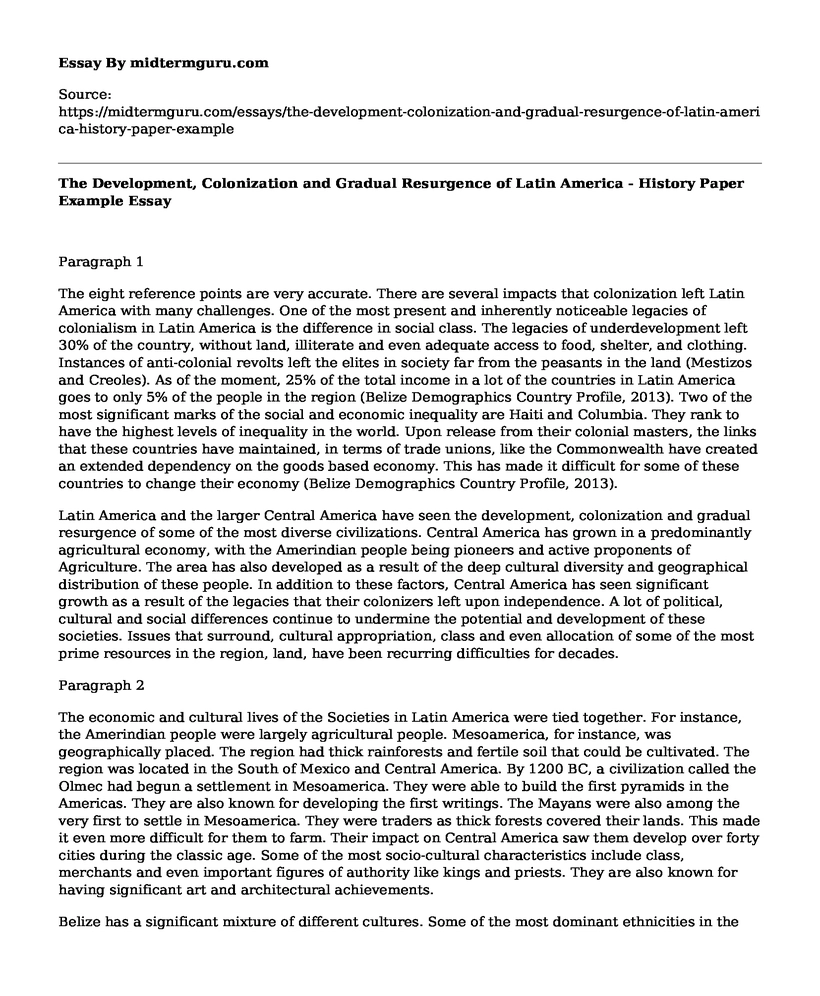Paragraph 1
The eight reference points are very accurate. There are several impacts that colonization left Latin America with many challenges. One of the most present and inherently noticeable legacies of colonialism in Latin America is the difference in social class. The legacies of underdevelopment left 30% of the country, without land, illiterate and even adequate access to food, shelter, and clothing. Instances of anti-colonial revolts left the elites in society far from the peasants in the land (Mestizos and Creoles). As of the moment, 25% of the total income in a lot of the countries in Latin America goes to only 5% of the people in the region (Belize Demographics Country Profile, 2013). Two of the most significant marks of the social and economic inequality are Haiti and Columbia. They rank to have the highest levels of inequality in the world. Upon release from their colonial masters, the links that these countries have maintained, in terms of trade unions, like the Commonwealth have created an extended dependency on the goods based economy. This has made it difficult for some of these countries to change their economy (Belize Demographics Country Profile, 2013).
Latin America and the larger Central America have seen the development, colonization and gradual resurgence of some of the most diverse civilizations. Central America has grown in a predominantly agricultural economy, with the Amerindian people being pioneers and active proponents of Agriculture. The area has also developed as a result of the deep cultural diversity and geographical distribution of these people. In addition to these factors, Central America has seen significant growth as a result of the legacies that their colonizers left upon independence. A lot of political, cultural and social differences continue to undermine the potential and development of these societies. Issues that surround, cultural appropriation, class and even allocation of some of the most prime resources in the region, land, have been recurring difficulties for decades.
Paragraph 2
The economic and cultural lives of the Societies in Latin America were tied together. For instance, the Amerindian people were largely agricultural people. Mesoamerica, for instance, was geographically placed. The region had thick rainforests and fertile soil that could be cultivated. The region was located in the South of Mexico and Central America. By 1200 BC, a civilization called the Olmec had begun a settlement in Mesoamerica. They were able to build the first pyramids in the Americas. They are also known for developing the first writings. The Mayans were also among the very first to settle in Mesoamerica. They were traders as thick forests covered their lands. This made it even more difficult for them to farm. Their impact on Central America saw them develop over forty cities during the classic age. Some of the most socio-cultural characteristics include class, merchants and even important figures of authority like kings and priests. They are also known for having significant art and architectural achievements.
Belize has a significant mixture of different cultures. Some of the most dominant ethnicities in the country include Latino, Maya, Mennonite, Creole and Garifuna. The Latinos remain the largest ethnic group in Belize accounting for nearly 50% of the total number of people. Creoles are the second largest group, accounting for 21%-25%. The Maya and Garifuna then make up for 10 and 4.6% respectively (Belize Demographics Country Profile, 2013). Each of the cultures in the country continues to practice Roman Catholics, an influence of their colonial masters. 50% of the total population in Belize are Roman Catholics while 8.5% are Pentecostalism. The rest of the population observe a mixed religion (Belize Demographics Country Profile, 2013).
References
Belize Demographics Country Profile 2013 | With Belize Census Data. (2017).Belize.com. Retrieved 25 January 2017, from https://www.belize.com/belize-demographics
Cite this page
The Development, Colonization and Gradual Resurgence of Latin America - History Paper Example. (2021, May 31). Retrieved from https://midtermguru.com/essays/the-development-colonization-and-gradual-resurgence-of-latin-america-history-paper-example
If you are the original author of this essay and no longer wish to have it published on the midtermguru.com website, please click below to request its removal:
- American Utopia - Essay Sample
- Essay on Raising of Age to Purchase Cigarettes in the State of Minnesota
- Why My Vote Matters? - Essay Sample
- Essay Sample on Homeland Security Paradigm
- International Policies on Weapons and Subsequent Effects on the Vulnerability of the Society - Essay Sample
- Paper Example on Limited Government
- Trump Revives Republican Plan to Reduce Federal Workforce - Essay Sample







